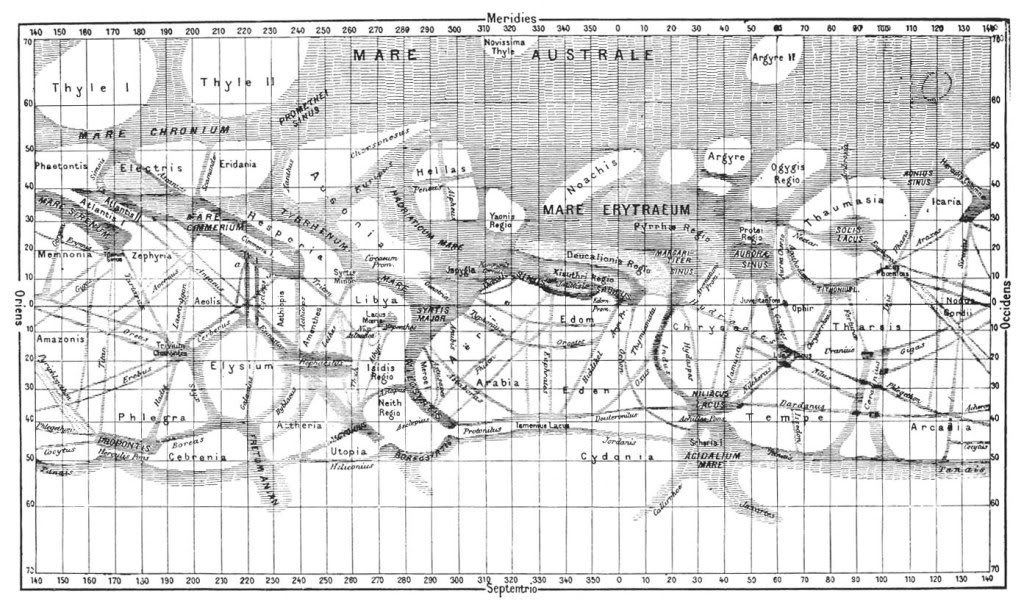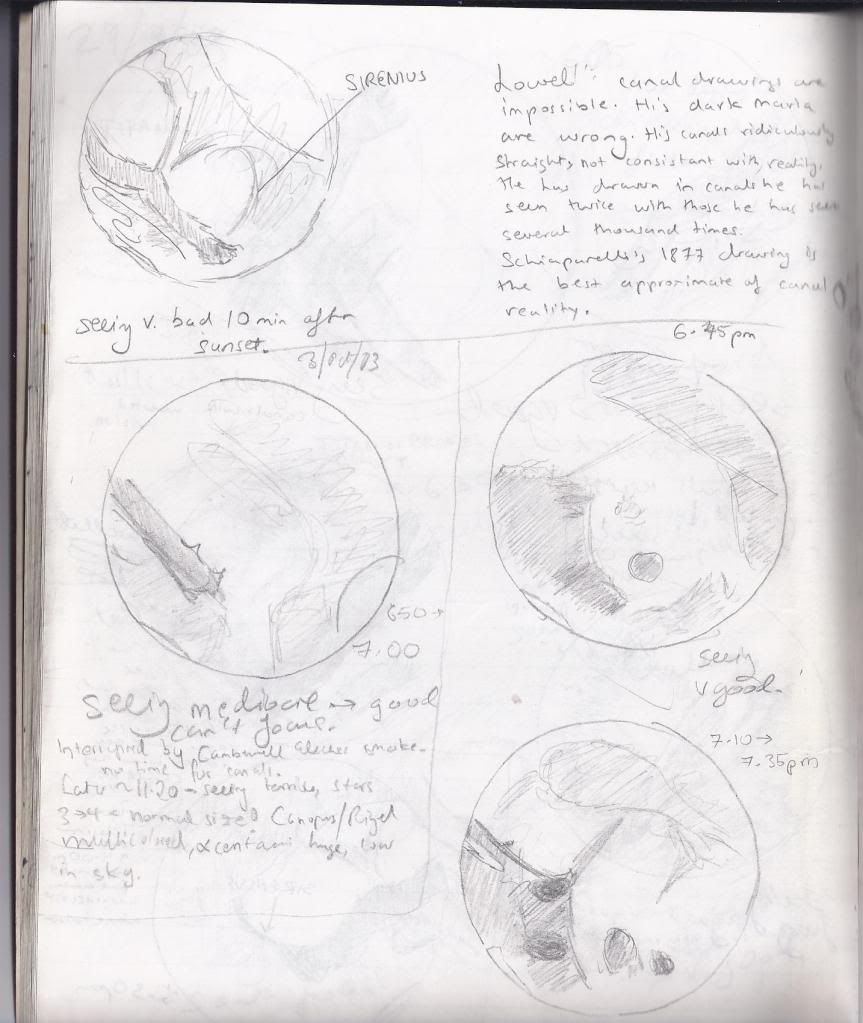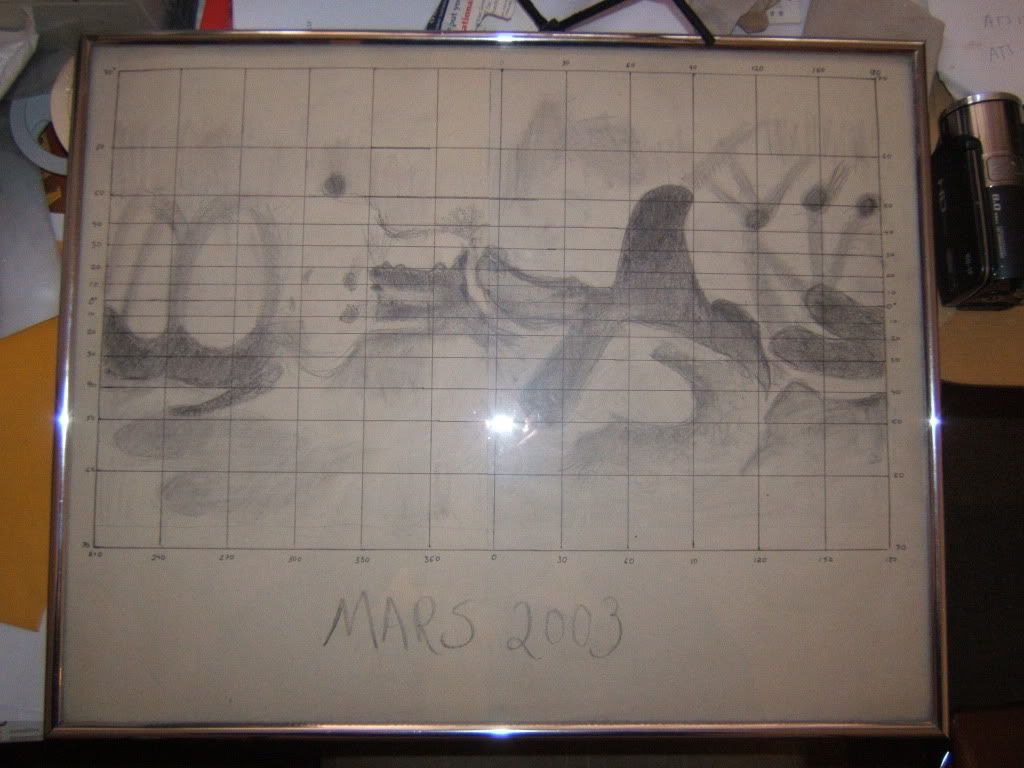My telescope finally arrived by freight and after setting it up, I had a good look at Saturn. I was greatly impressed. The view was not as great as would have been seen in finer scopes - the Cassini division between the rings, discovered in the seventeenth century, (in days when men had far worse telescopes), was barely discernible.
So what to look at! One of the reasons for getting such is short focal length telescope is to have a wide field of view for deep-space objects, such as galaxies. I thus eagerly sought out galaxies in star maps and moved the telescope towards them, only to discover there was very little to be seen. M104, the famous Sombrero Hat Galaxy was barely discernible in my city location. There was maybe just a faint hint of it... if I imagined hard enough, with averted vision. Quite simply, the city lights make the sky brighter than the light of the galaxies, which is trying to peak through.
The good thing about 2003 was that Mars would make a fabulous appearance, in August of that year. It would not only be in opposition, (on the same side of the sun as Earth, and thus 'close'), but it would be a Perihelic opposition! (Planets have elliptical orbits. A perihelion is the closest point to the Sun in a planet's elliptical orbit. This would also make it closer to Earth). It was a once in 60,000 year opportunity!
Thus Mars, normally a tiny barely disernable red dot, grew into a somewhat more intimidating red orb high in the sky. At it's closest, in late August, I observed it above the garage from my driveway in the setting sun, and timed the moment at which it was closest, for obversvation. I swear, I could easily make out a disk with the naked eye. That's how frighteningly close it had become. It no longer resembled one of the stars... it was an intimidating spot of red fire, and could have been a distant moon of Earth, were we not better informed.
I had always thought that planetary work would be rather boring..... but was I in for a surprise! For me, looking at this little planet with the scope, and drawing the features, was one of the most exciting adventures of my life!
I began to read and read all about Mars! Every day I would go out in the evening and would notice that red dot getting bigger and bigger. I read in the history books, and online, about a wealthy Boston millionaire and mathematician called Percival Lowell. I desperately wanted to see what he saw... canals! Was my scope big enough? He had used a 24 inch refractor which had cost an enormous amount to build, just to study the red planet during a favorable opposition.
I was reassured by two things... 1) Mars was far closer in this opposition that Lowell had ever seen it, and 2) Lowell and others had seen the canals with as little as an eight inch refractor.
Lowell had been inspired by an Italian astronomer by the name of Giovanni Shiaparelli. Basically, Schiaparelli started seeing canals on the surface of the planet in the 1880s.
Map of Mars by Giovanni Shiaparelli, 1877:
Schiaparelli made a second map for the next opposition, three years later. In this map, the canals look more 'man made'. It is perhaps a bit of a popular myth that Shiaparelli's canali is a 'mistranslation', and that he really meant 'channels', rather than English canals. Perhaps he did, but iT seems he really did mean canals later on, and seemed to suspect they were artificial.
Here are his sketches, from I believe 1881-1882. He noticed a phenomenon called 'twinning' in which canals seemed to have split apart and were double tracked.
Here are his sketches, from I believe 1881-1882. He noticed a phenomenon called 'twinning' in which canals seemed to have split apart and were double tracked.
Lowell was hugely captivated by Schiaparelli's findings. Here are some of his strange 'pre-art deco' drawings of the canals on Mars. These were made at the end of the 19th century, and towards the beginning of the 20th century.
Lowell pieced all his drawings together to make this map of Mars, made with his 24" Refractor at Flagstaff, Arizona:
"That Mars is inhabited by beings of some sort of other we may consider as certain as it is uncertain what those beings may be."
~ Percival Lowell
~ Percival Lowell
As Mars got bigger and bigger... I began to draw what I saw... Not much at first, very faint outlines... I had to look for about 10 minutes before I could even see anything. Finally my brain would begin to piece it all together, and I would begin to draw! To my great relief, my drawings improved as the weeks went by and I learned to be an observer..
One day, I had the telescope set up on the back veranda during the day time and was busy sketching the moon. Then suddenly, I spotted Mars, fully visible in daylight. I decided to begin sketching it. By this time, Mars was rapidly receding, getting smaller with each day that went by, so I was running out of time to see the fabled canals, which had so eluded me! Even if they were mere tricks of the light, they would surely be visible!
I swung the telescope around to look at Mars. A relatively featureless plain of the planet was presented towards Earth. I observed for about ten minutes and then I noticed something..... I could see Schiaparelli's canals! I called my brother over... 'ummmmm... I think I can see the canals!' .... The so-called canals which 'do not exist' were very visible to me! I drew them. I let my brother have a look and he too could see them! The seeing conditions were truly optimal and the canals were clearly visible.
Here are a few of the sketches I made of this elusive planet. Upper left sketch represents very clear 'canals', almost as dark as the rest of the conventional Martian features.
Here are more sketches, which I placed on the Ice in Space forum, to present them to the wider astronomical community: : )
http://www.iceinspace.com.au/forum/showthread.php?t=73916
Anyway, this is my map of Mars, assembled from about 60 diagrams of the planet, made mainly as Mars was receding away from the Earth, after the 27 August Opposition. Syrtis Major (bold), is very prominent. It is a huge mountain range. The 'canals' which are really perhaps mountain ranges, are drawn in exaggerated shading as they are normally not visible, except what I would call 'peculiar' seeing conditions. The map is representative of the Shiaparellian curved canals, not the straight Lowellian ones, which were not seen. Those may have been tricks of the light. I flatter myself that it looks quite similar to the Hubble Space Telescope Image of Mars, made in 2003, (below).
I strongly suspect that NASA cameras, (and cameras in general), are not sensitive to the light frequency required to see the canals, or required to piece images together. We see with our minds, our eyes are an instrument. There appear to be shadows of the canals evident on the Hubble photographs, but as always, they simply do not show up very well on photographs at all! Several 'canals' look like strings of craters.
I have a number of theories regarding the Martian Canals:
1) They are strings of bacterial life living on mountain ranges which, as on earth, approximate straight or bent lines. These change in color with the seasons. It used to be thought that the wave of darkening was caused by the plants appearing in the land irrigated by canals.
2) They are a psychic presentation, a spiritual vision of a vanished civilization... a presentation by God, to humanity, of what may one day occur on Earth... desolation and ruin.
3) They are actually there but are evident in a wavelength not visible to human cameras which tend to pick up the infra-red to visible wavelength. The fact is, some astronomers can see them, and some can't. This tells me a particular wavelength, (or type of imagination!) is required. Patrick Moore spent 70 years observing Mars and never professed to have never seen a canal, (yet his map appears to contain at least two....Patrick Moore on Mars, 1998, p. 92). Some famous astronomers have seen canals, most have not.
4) Even if they are mere strings of craters, the 'wave of darkening', if real, suggests something seasonal and mysterious is going on.
This was one of the greatest projects and adventures of my life! I love this stuff!
References:
Patrick Moore, Patrick Moore on Mars, 1998.







The arrival of the United States' Mariner 4 by NASA in 1965, which took pictures revealing impact craters and a generally barren landscape, was the final nail in the coffin of the idea that Mars could be inhabited by higher forms of life. A surface atmospheric pressure of 4.1 to 7.0 millibars (410 to 700 pascals) and daytime temperatures of −100 degrees Celsius were estimated. No magnetic field[4][5] or Martian radiation belts[6] were detected.
ReplyDeleteWilliam Kenneth Hartmann, a Mars imaging scientist from the 1960s to the 2000s, explains the "canals" as streaks of dust caused by wind on the leeward side of mountains and craters.[7]